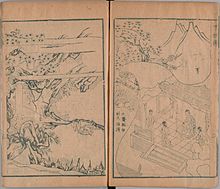Pingyao Zhuan
 |
|
| Author |
Luo Guanzhong (14th century) Feng Menglong (16th century) |
|---|---|
| Original title |
三遂平妖傳 (Luo's version) 平妖傳 (Feng's version) |
| Translator | Lois Fusek (2010; Luo's) Nathan Sturman (2008; Feng's) |
| Country | Ming China |
| Language | Chinese |
| Genre | Chinese mythology, shenmo, fantasy, historical fiction |
|
Publication date
|
16th century |
| Media type | |
The Three Sui Quash the Demons' Revolt (三遂平妖傳) is a Chinese novel attributed to the 14th-century novelist Luo Guanzhong, although the earliest extant version was compiled between 1571 and 1589, possibly by Wang Shenxiu (王慎脩). In 1620, Feng Menglong expanded the novel to forty chapters from the original twenty. A work in the shenmo genre, the novel blends comedy with the supernatural, and is an early work of vernacular fiction.
The story is very loosely based on Wang Ze's failed 1047–48 rebellion during the Song dynasty.
The story is set in the Song Dynasty. Wang Ze, a military commander, marries the sorceress Hu Yong'er. Hu was conceived after her mother burned an enchanted painting. She was taught magic from a fox spirit, enabling her to conjure armies with her spells. The three sorcerers, Zhang Luan, Bu Ji, and the Egg Monk Danzi Wang, join Wang after a series of adventures battling corrupt officials with their supernatural powers.
Wang leads a revolt to overthrow the government with the help of the sorcerers. The three sorcerers grow disillusioned with Wang's impropriety and defect to the government forces headed by Wen Yanbo, who had arrived to suppress the rebels. The Egg Monk disguises himself as a monk by the name of Zhuge Sui and aids the imperial generals Ma Sui and Li Sui. Together, the Three Suis defeat Wang and end the rebellion.
Legends of Wang Ze and his revolt, a historical event, were popular since the Yuan Dynasty and commonly embellished with elements from Chinese mythology. The novel attributed to Luo Guanzhong is a shenmo novel loosely based on Wang's revolt and published in the 16th century. It is not certain if Luo is the genuine author of the novel. The appearance of lijia, a social institution for local governance in rural areas, suggests that the text was written during or after the 15th century, but this may have been an alteration by a later editor. The original copies of the book attributed to Luo are lost. The only surviving works of Luo's earlier story are a revised edition published by Wang Shenxiu and the Nanjing publishing house Shi Detang. Three copies of the revised novel are still extant. It contains twenty chapters, separated into four juan or sections.
...
Wikipedia
